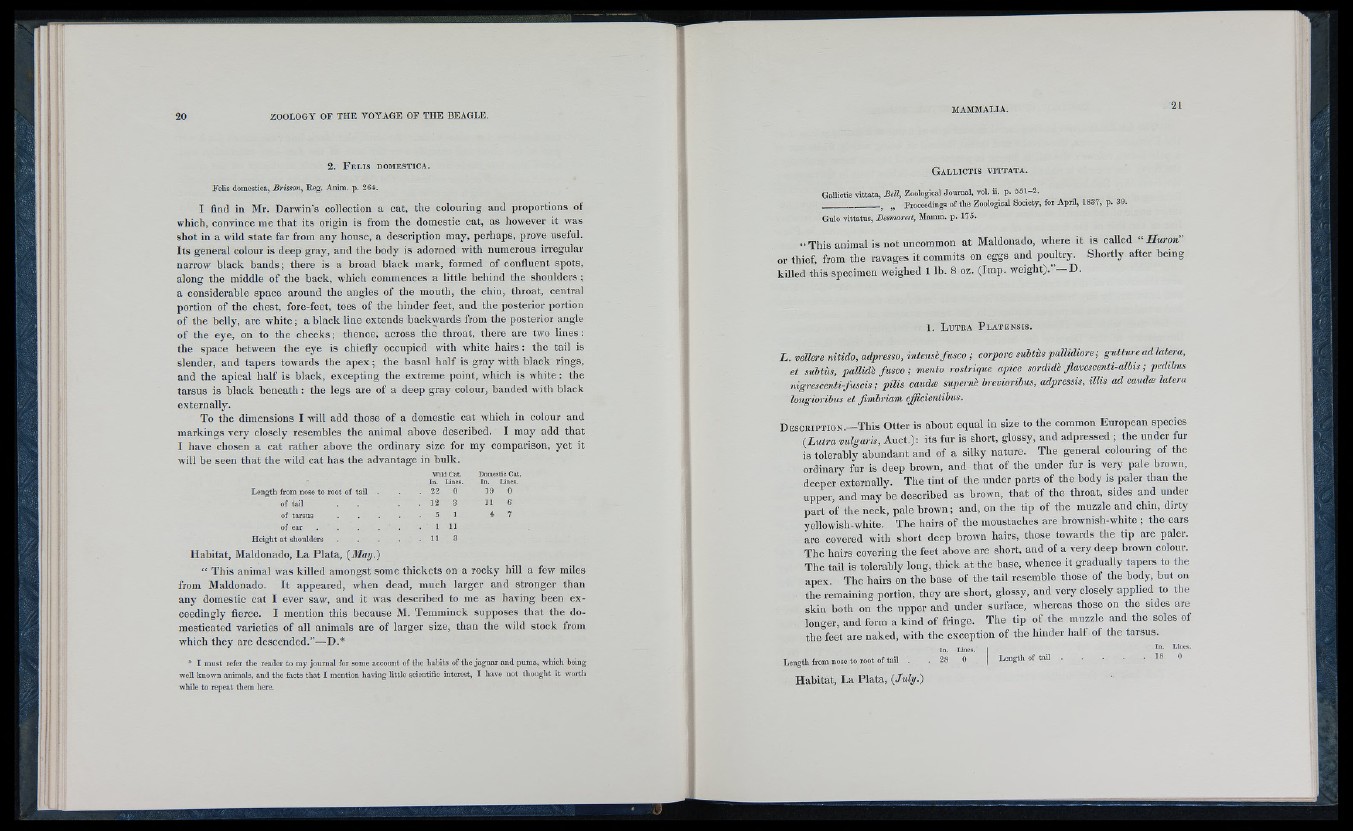
2. F e l is d o m e s t ic a .
Felis domestica, Bs'isson, Reg. Anim. p. 264.
I find in Mr. Darwin's collection a cat, the colouring and proportions of
which, convince me that its origin is from the domestic cat, as however it was
shot in a wild state far from any house, a description may, perhaps, prove iiseiul.
Its general colour is deep gray, and the body is adorned with numerous irregular
narrow black bands; there is a broad black mark, formed of confluent spots,
along the middle of the back, which commences a little behind the shoulders ;
a considerable space around the angles of the mouth, the chin, throat, central
portion of the chest, fore-feet, toes of the hinder feet, and the posterior portion
of the belly, are white; a black line extends backwards from the posterior angle
of the eye, on to the cheeks ; thence, across the throat, there are two lines :
the space between the eye is chiefly occupied with -white hairs : the tail is
slender, and tapers towards the apex ; the basal half is gray -with black rings,
and the apical half is black, excepting the extreme point, which is white : the
tarsus is black beneath : the legs are of a deep gray colour, banded with black
externally.
To the dimensions I -will add those of a domestic cat which in colour and
markings very closely resembles the animal above described. I may add that
I have chosen a cat rather above the ordinary size for my comparison, yet it
will be seen that the wild cat has the advantage in bulk.
Wild Cat.
In. Lines.
22 0
Domestic Cat.
In. Lines.
Length from nose to root of tail 19 0
of tail 12 3 11 6
of tarsus . . . . . 5 1 4 7
of ear .
H eight at shoulders
Habitat, Maldonado, La Plata, (3Iay.)
“ This animal was killed amongst some thickets on a rocky hill a few miles
from Maldonado. It appeared, when dead, much larger and stronger than
any domestic cat I ever saw, and it was described to me as having been exceedingly
fierce. I mention this because M. Temminck supposes that the domesticated
varieties of all animals are of larger size, than the wild stock from
which they are descended.”~ D .*
* I m ust refer the reader to m y journal for some account of the habits of the jaguar and puma, which being
well known animals, and the facts that I mention having little scientific interest, I have not thought it worth
while to repeat them here.
G a l l ic t is v it t a t a .
G a lW s vittata, Bell, Zoological Journal, vol. li. p. 551-2.
_______________ ^ Proceedinga of tlie Zoological Society, for April, 1837, p. 39.
Gulo vlttatus, Besmarett, Mamm. p. 175.
“ T h i s a n i m a l is not uncommon at Maldonado, where it is called “ Huron
or thief, from the ravages it commits on eggs and poultry. Shortly after being
killed this specimen weighed 1 lb. 8 oz. (Imp. weight). D.
1. L b t e a P l a t e n s is .
L . vdkre nitido, adpresso, intensi fusco ; corpore subtus pallidiore; gutture adlatera,
et subtùs, pallidè fusco ; mento rostrique apice sordidè flavescenti-albis ; pedibus
nigrescenti-fuscis ; pilis caudce supernh brevioribus, adpressis, illis ad caudce Utera
longioribus et Jimbriam efficientibus.
D escuiption.—This Otter is about equal in size to the common European species
(Lutra vulgaris, Auct.): its fur is short, glossy, and adpressed ; the under fur
is tolerably abundant and of a silky nature. The general colouring of the
ordinary fur is deep brown, and that of the under fur is very pale brown,
deeper externally. The tint of the under parts of the body is paler than the
upper, and may be described as brown, that of the throat, sides and under
part of the neck, pale brown; and, on the tip of the muzzle and chin, dirty
yellowish-white. The hairs of the moustaches are brownish-white ; the ears
are covered with short deep brown hairs, those towards the tip are paler.
The hairs covering the feet above are short, and of a very deep brown colour.
The tail is tolerably long, thick at the base, whence it gradually tapers to the
apex. The hairs on the base of the tail resemble those of the body, but on
the remaining portion, they are short, glossy, and very closely applied to the
skin both on the upper and under surface, whereas those on the sides are
longer, and form a kind of fringe. The tip of the muzzle and the soles of
the feet are naked, with the exception of the hmder half of the tarsus.
Length from nose to root of tail .
Habitat, La Plata, (July.)
Lines.
0 Lengtli of tail
Lines.
0